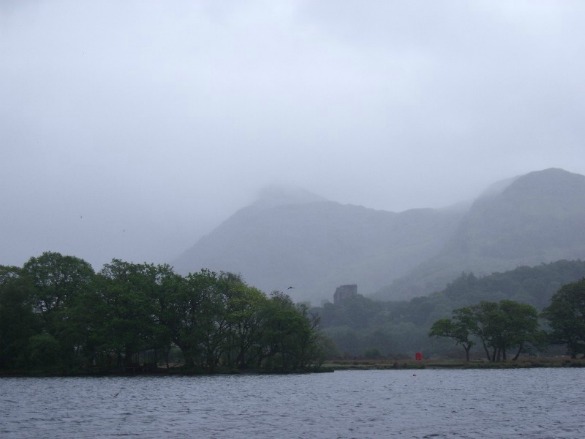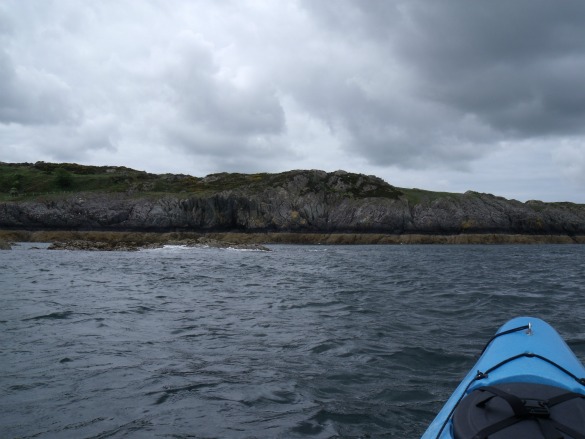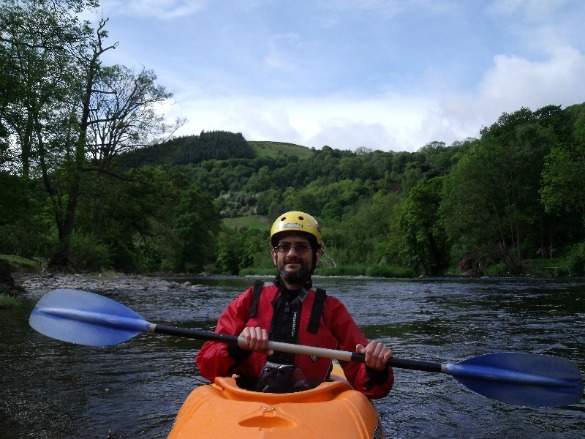I have found that kayaking is never the same game twice. For this activity continues to offer me the chance to appreciate the treasures of Mother Nature from a non-land perspective. I explored some of Wales’ natural beauty through three kayaking excursions, each different because of the country’s geographical location that offers not only river and lake kayaking, but paddling on the sea would become something I added to my accomplishments.
Lake Kayaking in Padarn Country Park
Just nestled inside Snowdonia National Park in the north at Llanberis is Padarn Country Park (a short drive from Caernarfon). The 800 acres seems such a low key and unassuming place for kayakers, rock climbers, and hikers. Yet due to its abundance of slate, it was once dominated with the activities of mining so as to supply the world’s roofing needs.

I found much to keep me occupied on the long Llyn (Lake) Padarn, kayaking five miles around its shores, which contained slate-landscaped lagoons where oak and ash trees stood guard over the daffodils during a steady drizzle. My kayak, a Wilderness Tarpon sit-on top that weighed just under 50 pounds and was about 10 feet long, was suited greatly for the lake, transporting me around the finger shape where I took in the sights and sounds of mallard ducks, herring gulls, gray wagtail, and swallows as the short gauge sightseeing railway engine was tooting its horn along the shoreline.
Jim, my experienced Surflines guide of ten-plus years, took us out into the middle of the lake, with its deepest point at about 100 feet. Through the rainy mist, I was captivated by the sight of what’s left of one of Wales 500-plus castles, Dolbadarn Castle, dating from the 13th century. But the gusts of winds picked up in the middle of the lake and rain fell heavier, making it quite a challenge to get many good photos.
So we once again retreated to the lagoon areas, where on sunnier days, the picnic tables on the shore would be full of relaxing locals, but during my time, this area served as a respite from the blowing rain.
Exploring a slice of Anglesey’s sea coastline
The Isle of Anglesey lies just off the northwest mainland of Wales, and contains some 125 miles of coastline to kayak around. I’ve always wanted to experience the thrills of paddling in more challenging waters, and got that opportunity as I trekked around some of the steep and rocky North Anglesey Heritage Coast, where once copper mining was king. I paired up with John of Surf Lines, who has 30 years kayak experience, including coaching and guiding.
We used a Looksha 18.1 foot two-seater, that weighed some 92 pounds, to navigate on Liverpool Bay (part of the Irish Sea). Our starting point on a mostly cloudy day was Porth Elian Beach with the goal of reaching the harbour of the old copper mining port of Amlwch in an hour. The journey began from Port Elian in the midst of relative calmness from the more turbulent waters beyond, where wind speeds were gusting around 20 mph and also into our initial direction. While easily managed by more experienced sea kayakers going solo, I chose to paddle in that two-seater with someone experienced.
Immediately as we got into Liverpool Bay, I noticed the various colors of the lower part of the cliffs, as the tidal zone section on the bottom third left them brown, while the more forceful splash zones created gray and black colors, the latter as the result of the stormiest of seas. The kayak moved swiftly through the waters as I heard the constant screeching of Herring Gulls above me, and who often found resting points on the rock formations that jutted out into the seawater.
Guillemots, black Great Cormorants, and orange-beaked Oystercatchers were flying above waters from 10 to 30 feet deep. Every now and then, the salt water would splash onto the boat and get into my mouth, making me spit it out quickly.
As we trekked along the coast, a little cove within the cliff formations appeared, and beyond that was what looked like an old mine shaft. We decided to check it out. As we entered the cove, the noise from the protesting waters in the bay all but disappeared. It was like being in our own world. After safely managing to get out of the kayak through careful grabbing and stepping onto the sharp and jagged rocks at the water’s edge, we proceeded upwards for about 200 feet to the cave, having to be cautious of the slippery seaweed and more jagged rocks. Just outside the mysterious cave (possibly an exploratory mine shaft), the only treasure we found was a washed up milk bottle.
The winds began whipping up a bit more, meaning we had to paddle with more force just as we passed an old bromide factory and before entering through the opening in the massive and protective harbor walls of Amlwch at low tide, which has pilot boats stationed there to take in large container ships to Liverpool through its tricky bay if needed.
We noted boats that were on basically dry land temporarily until the tide came back hours later, enough time for the crewman to do maintenance work. We then headed back to our original starting point with the wind at our backs, making it back in about 30 minutes.
In between my talks with my friendly guide and as we discussed various non-kayaking subjects, I pondered a couple of ships sitting on the horizon, where the blue waters seemed to go on forever and ever into a grayish landscape above.
An involuntary “baptism” in the River Dee
The River Dee runs through the purported home of the keeper of the Holy Grail, the unfortunate Fisher King, whose wounds kept him from ruling his kingdom. This legendary river starts in the mountains of Snowdonia and flows to Liverpool, but along the way are some whitewater kayaking opportunities, one which I found just outside the Welsh city of Llangollen in County Denbighshire, about a 45 minute drive from the Beatles’ mecca.
Lush greenery and steep hills surrounded the river, where the remains of Dinas Bran Castle sits on one such high place reached by hiking up a steep hill. That’s the setting of a Welsh 12th century tale of a Norman knight Payn Peveril, who successfully defended himself and his men against a menacing giant named Gogmagog.
Like sea kayaking earlier, whitewater kayaking was something new to me, so I got three hours worth of lessons from a 20 year-plus whitewater veteran John of Whitewater Active (he looks like Virgin founder Richard Branson) in Grade 2 to Grade 3 waters, where rescue operation training happened to be taking place. From the shores, the river didn’t look that challenging, but for whitewater novices like myself, I would find out otherwise.
John showed patience but was firm in expecting his students to have a positive attitude about taking on new challenges, rather than make excuses. After being fitted in whitewater gear, and having to drag out a made-for-spinning Pyranha G:3 275 Rapid that spanned about 9 feet and weighed well over 100 pounds, I set off into the water to learn a variety of skills useful for whitewater rivers and their currents. This included eddying in and out, ferry gliding from one bank to the other, sweep stroking (leverage to spin), stopping, and portaging up the river, and handling the paddles right.
The sun finally broke out in lightly breezy conditions and made for a rather pleasant morning as we finally began moving with the speedy current. Because I have a tendency to be a fraidy cat when something I don’t feel control over starts going fast, I was anxious as I initially moved down the first couple of Grade 2 rapids, the whitewater sections acting like a washing machine agitating dirty clothes. On one such rapid, I immediately spun around, but didn’t capsize.
John stressed the “leadership system,” expecting us to do what he told us to do without questioning him so as to establish trust with him. So when a couple of us began to follow him towards a Grade 3 rapid, I felt reluctant as the current sped up and looked like what was going to be more of a watery roller coaster ride. Rather than follow him exactly where he kayaked to (the right part of the “V” in the river), I took a left straight into the rapid. Thinking I was all right, I stopped paddling and got immediately caught in the agitation, and suddenly capsized. All I could think of was getting out of the kayak and hoping my camera would stay dry in my waterproof pouch and my glasses wouldn’t fall off.
After a couple of seconds, I emerged out of the water totally wet, but my wet suit kept me warm in the semi-raging river, my glasses and camera in tact. The kayaker following me met the same fate. More lessons followed after getting the water out of the vessels, and despite being wet from my involuntary “baptism” in the river.
Welsh accommodation recommendation
I stayed at the Swallow Falls Inn, which is a short trek to the base of Mt. Snowdon. The rooms are nice and quaint, and the beds are very comfortable. Breakfast and the internet are free, but sometimes surfing online is a bit slow because of its location in Snowdonia National Park. This accommodation dates back to Victorian times and is near Swallow Falls, where trekkers there have to pay £1 to open a gate to walk to the natural wonder. The inn also serves as a youth hostel.
Photos credits by Roy A. Barnes, and may not be used without permission. Roy A. Barnes attended a press trip sponsored by Visit Wales, but what he wrote were his own impressions without any scrutiny or vetting by the sponsor.
>> For more kayaking adventures, read Seeing Door County by Kayak

